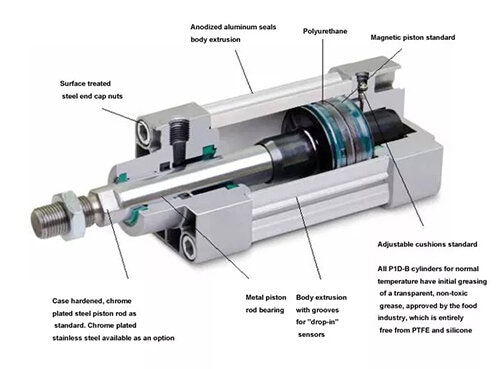What is piston air cylinder?
Air piston cylinder is the cavity in the cylinder block of the internal combustion engine where the piston is placed and is the orbit of the piston movement, in which the compressed air burns and expands, and through the cylinder wall, it can also dissipate a part of the residual heat of the explosion transmitted by the compressed air, so that the engine maintains a normal working temperature.
Pneumatic piston cylinder can generally be divided into single-acting and double-acting according to the mode of action,Single acting means that the piston completes the return movement under the force of a spring, while double acting relies on compressed air for both the extension and return of the piston.In order to maintain close contact between the cylinder barrel and the piston, and to reduce friction during piston movement under the action of compressed air input to the cylinder,
the inner wall of the cylinder should have high machining accuracy and precise shape and dimensions.
Due to the use of compressed air as the power source, pneumatic piston cylinder is widely used in the industrial and automation fields due to its advantages of environmental protection, cleanliness, and flexibility.We have widely concerned piston pneumatic cyclinders are: DNC Series ISO6431 Standard Cylinder, SI Series ISO15552 Standard Cylinder, CQ2 Series Compact Cylinder.
Structure and Working Principle of Piston Air Cylinder
A pneumatic piston cylinder consists of a cylindrical barrel, a piston, a piston rod, and end covers. When compressed air from atmosphere enters one side of the cylinder, As mass air is injected, the pressure of compressor air increases, and the strong air force pushes the piston to move in a straight line along the barrel.That's why it's called a pneumatic air actuated cylinder or actuator.There are two ways to retract the extended cylinder piston rod:
Single-acting cylinders use air compressor to move the piston in one direction, with a spring or external force returning it to its original position.
Double-acting cylinders use air pressure on both sides of the piston, allowing bidirectional motion.
Inall,both have only one piston rod, it's just that the way the piston rod is recovered is different.
Types of Piston Air Cylinder
A pneumatic piston cylinder uses compressed air transported in cylinder as the power source, and the piston rod serves as the driving component.It has multiple types as follows:
Standard Cylinders – Designed for general industrial applications, available in various bore sizes and stroke lengths.
Compact Cylinders – Shorter stroke lengths with a space-saving design, ideal for applications with limited installation space.
Rodless Cylinders – Utilize an internal mechanism to provide motion without an external piston rod, suitable for applications requiring long strokes.
Guided Cylinders – Integrated with guide rods or bearings to enhance stability and precision.
Rotary Cylinders – Convert pneumatic energy into rotational motion for specific industrial uses.
Advantages of Air Piston Cylinder
A pneumatic piston cylinder uses compressed air as the power source, and the piston rod serves as the driving component.It has many advantages.
High Speed and Responsiveness – Pneumatic Piston cylinders operate quickly, making them ideal for fast-paced automation.
Durability and Reliability – Made from high-quality materials such as aluminum or stainless steel, ensuring longevity.
Cost-Effective – Compared to hydraulic and electric actuators, air cylinders have a lower initial and maintenance cost.
Safe Operation – Air-powered systems reduce the risk of fire hazards associated with hydraulic fluids.
Environmental Protection - Non polluting Emissions
Applications Of Air Piston Cylinder
A air piston cylinder uses compressed air as the power source, and the piston rod serves as the driving component.It has mang application.
Manufacturing – Assembly lines, material handling, and automation.
Packaging – Sealing, labeling, and cutting operations.
Automotive – Pressing, stamping, and robotic automation.
Medical Equipment – Precision-controlled motion in diagnostic and laboratory equipment.
Customization and Selection
Pneumatic piston cylinder before you choose need to consider involves factors such as bore size, stroke length, operating pressure, and mounting type. We provide customization options, including special coatings, seals, and rod modifications, allow adaptation to specific operational environments.
Fescolo not only offers a range of air piston cylinders, but standard and customized solutions to meet diverse industrial air system requirements. For more details or assistance in selecting the right piston cylinder, contact our professional team.
Moreover:A piston air cylinder contains air at 600 kpa
Pressure, Volume, and Temperature:
These three variables are interrelated in the ideal gas law, which states that
PV = nRT (where P is pressure, V is volume, n is the number of moles of gas, R is the universal gas constant, and T is temperature). At 600 kPa,
if we know the volume and temperature of the air, we can determine other properties of the system, such as the density of the air or the total energy content of the gas.
State Changes:
If the piston is movable, the volume of the pneumatic cylinder may change, leading to work being done on or by the gas. If the gas is compressed, the pressure will increase, and the temperature may rise unless the system is cooled. Conversely, if the gas is allowed to expand, the pressure will drop, and the temperature may fall, following principles described in the first law of thermodynamics (energy conservation). These processes are fundamental in many engineering systems, including engines, compressors, and air conditioning systems.
A piston cylinder system with air at 600 kPa is similar to the conditions inside the cylinders of many internal combustion engines or pneumatic actuators. In internal combustion engines, the air-fuel mixture undergoes compression before ignition, generating power. The pressure and volume relationship plays a critical role in engine efficiency. In pneumatic systems, controlled compression and expansion of air in pistons drive machinery, from industrial presses to robotic arms. The knowledge of air pressure, volume, and temperature is essential to optimizing these systems for maximum efficiency and safety.
For more information, please feel free to Contact us.















